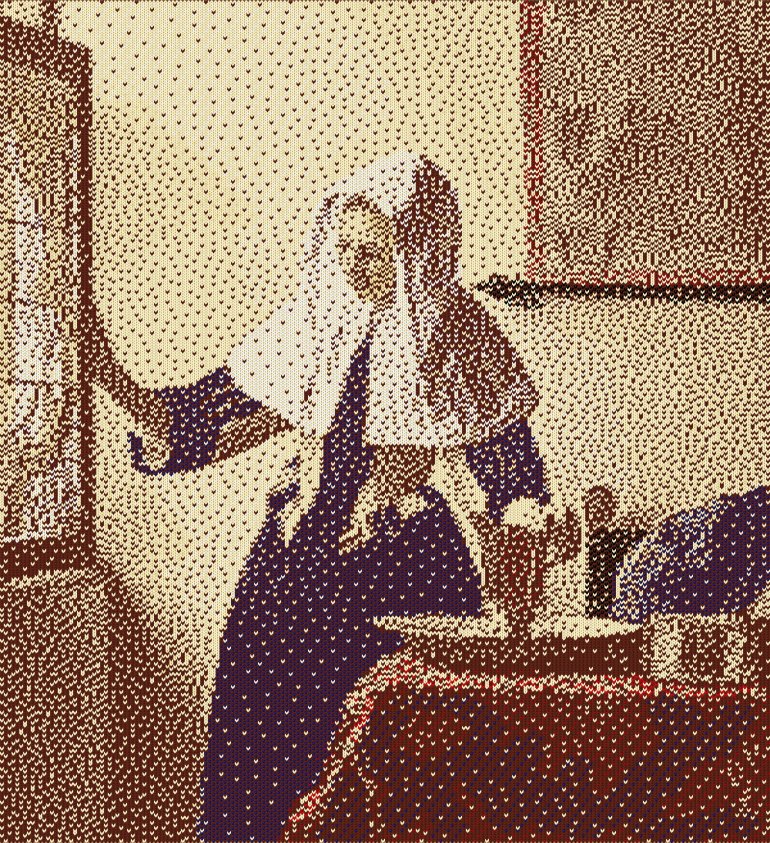SOME THOUGHTS ON THE WAY TO AN ARTIST STATEMENT…
NOT A BLOG, BUT AN OCCASIONAL
DISCUSSION OF IDEAS I’M WORKING ON
May 9, 2020: Remixing continues
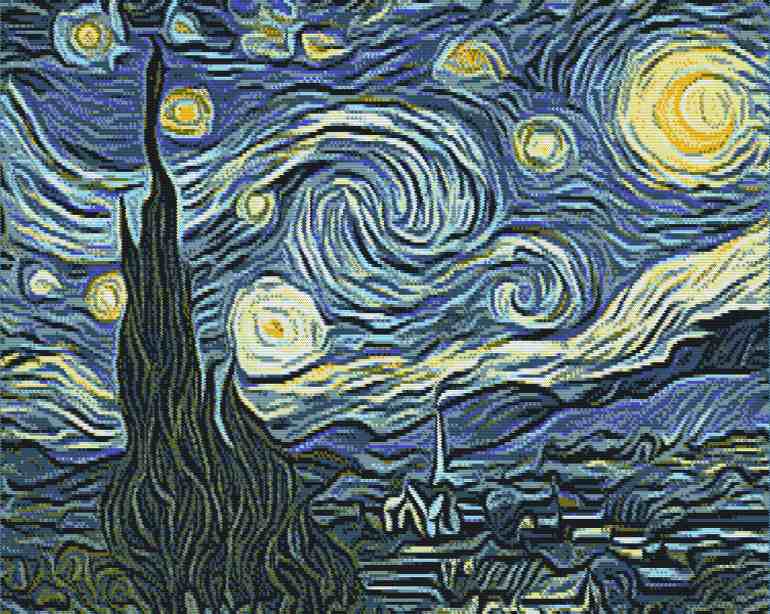
Here’s today’s remix. You know what it is. It pushes further than any previous ones into the integration of multiple colors (still just nine of them, a tiny handful compared to the blended paint colors in the original) throughout the image. I give Photoshop credit for some of the heavy lifting here, but I still know a lot more about yarn and how knitting works than it does.
And I have to say, I am really enjoying this.
Making “remixes” of historic artworks, that is, and presenting them as if they had been executed in knitting instead of painting, or photography, or sculpture, or whatever.
Did it take a pandemic for me to figure this out? I mean, that would be really sad, wouldn’t it?
But maybe it makes sense. Creating these remixes is about 90% analysis and 10% aesthetics…which makes it ideal for a time in which I’m actively avoiding looking too closely at my emotions most of the time. Maybe this is exactly what I should be doing right now. I’m developing some new techniques and pushing the boundaries of my images along the way, so what’s not to like?
And as I’ve been thinking about these pieces (thinking rationally, not emotionally, of course 😉), another angle has occurred to me.
Digression: keep in mind, I’m a believer that you should make work that is meaningful to YOU, even work that is meaningful ONLY to you, and let that work make its own connections to other people later if it can. In other words, make each piece the way it tells you must be made, and figure out how to explain it later. So this is one of those explain-it-later things…but it ties everything together so neatly that I have to believe it was there under the surface all along.
So here it is: one might look at the presentation of famous historic artworks AS IF THEY HAD BEEN KNITTED as a feminist re-imagining of them. Starting with a great painting, for example, that was made at a time when few women had the opportunity to paint, I translate it into a medium that WAS allowed to women: knitted yarn. But knitting has all kinds of limitations as a picture-making material, including the size of a stitch (its most basic “mark-making” element) and the available colors of yarn. So in showing what can be done within these limitations, I am…what? Thumbing my nose at the patriarchy? Pfft. That’s not something I’ve spent a lot of time doing, to be honest.
Another digression: I grew up in what I think might have been a narrow age cohort of women who were raised to believe that of course, they could do anything, but who then discovered in adulthood that yes, technically that might be true, but also things were way, way more complicated than that. Maybe every age cohort of women has faced that situation; if so, maybe mine was unusual only in being perhaps the FIRST to face it. In any case, I didn’t grow up believing I needed to be a feminist. I thought all that stuff was fixed. Until I saw that it wasn’t.
So, back to the patriarchy. I didn’t really plan to thumb my nose at them. I’m just making (or remixing) artworks because I enjoy the process. If in that process I’m also demonstrating that surprising things can be done within the rules and limitations traditionally imposed on women, yay. And if my unique (and still evolving) process adds another twist by taking knitting into the digital sphere, making it virtual and simulated rather than physically knit out of actual yarn…well, in the gamergate era, maybe that’s an even more culturally relevant way to thumb your nose.
Make of all this what you will. In the meantime, I’m going to go tease apart the colors on some haystacks.
May 1, 2020: Making the best of things
My first news today is presentation of the newest work in my portfolio, which is…something different. I’m calling it an “Old Masters Remix” as it’s a re-imagining of a well-known painting as if it were rendered in knitting.
This first “remix” is of the painting “Young Woman with a Water Pitcher” by my favorite painter, Johannes Vermeer. (The actual painting hangs in the Metropolitan Museum of Art in New York.) I began this project as a demonstration work for students, to show them an example of how to approach an existing image to transform it into knitting. That is, once you know you’re starting with an image that’s compositionally balanced and has good color and contrast, THEN what do you do to make it work in knitting?
In my teaching presentation, I showed the effects of gradually reducing the number of pixels and number of colors in the image, and the enhancements needed to make the much-reduced image clear and convincing. I even knitted the final design, in two colors, and showed it to the students with an explanation of what colors I would add with duplicate stitch to make the image as accurate as possible. But I never completed the very time-consuming mounting and duplicate stitching for the piece, thinking that there wasn’t much potential to display it. I obviously couldn’t present it as a completely original work, as is typically required for juried exhibitions.
And then I started creating works in DIGITAL knitting.
Suddenly “finishing” the piece because a very useful process for me, a perfect test to see what was possible when I could use as many colors as I wished (still keeping the number to something that could be executed with real yarn, but not requiring the many, many hours of handwork that would be required to actually do so).
The new DIGITAL work is an ideal example of a complex image simplified to work in a minimalist medium of (in this case, simulated) knit stitches. The image above is very large, but if you zoom in and look closely at it (you can do this by clicking on the image to open it in a “lightbox” and then pinch-zooming with your fingers)—you’ll see all my techniques at play here. I’m really excited to keep applying these techniques to other well-known paintings and do some more “remixing”!
And that brings me to the second news for the day—high-resolution prints of the “Young Woman” are the first items available in my newly revamped Etsy shop (https://www.etsy.com/shop/ImageKnits). The shop will now focus on prints, as they can be offered at MUCH more friendly price points than full-size knitted pieces. Many of my previously knitted designs will be available as prints in the shop soon, along with more “remixes” and new opportunities for custom commissions. Check it out, and message me if you have questions or suggestions!
April 16, 2020: It’s a very different world now
It’s been a crazy few weeks, people. Seriously. And it’s nowhere near over.
I’ve thought for several days about what to say online, what photos to post, what images to work on. And although I’m writing this now, I never really reached a conclusion about what was appropriate. So I’m just winging it.
I should say upfront: I am extremely grateful that my family has stayed safe, healthy, and relatively secure. We should be able to weather this. We are trying (mostly because my husband has better instincts than I do for this sort of thing) to figure out how we can help others in small ways.
Still, there’s no denying that expectations and priorities have changed. And there’s no way to predict what the world—and all the little niche parts of the world in which we were happily, obliviously operating up through February—will look like on the other side of the pandemic.
I’m having a hard time with this. I think of making artworks as an activity that requires getting in touch with emotions, but that is the very LAST thing I want to do right now. I’m afraid emotions may overwhelm me if I get too close to them. But…if I manage to avoid my emotions, will I then just look clueless and disconnected?
I can’t solve this. I don’t have the right words, and I can’t figure everything out. I’m often having trouble figuring out what to do next, and I’m flailing around a lot. But I really, really love making artworks, using the weirdly personal methods I’ve developed over the last few years, so I will try to continue making them no matter what the post-COVID-19 world looks like. I will try to make some that have some relevance to current events, and maybe some that are a pleasant distraction from those events.
I will try to stay grounded as I write about the works I’m making. But maybe…I’ll also try not to take things too seriously all the time (though “too serious” is my natural mode of operation, so it may be really hard to shake).
Can I start by sharing a really big, determined-to-think-positive image? It’s the last work I completed just before the world changed. It was made to be a little bright, sunshine-y image for the gray and gloomy end of winter…and has become a reminder of the stubbornly cheerful normalcy of breakfast, when pink grapefruit in a green bowl still helps me wake up.
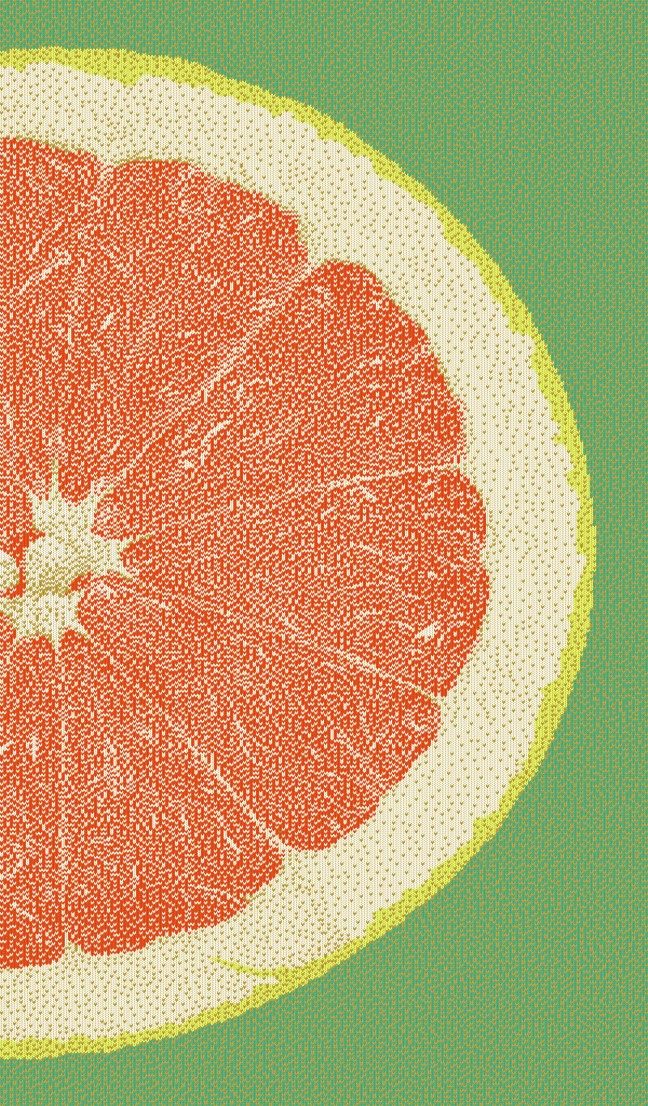
TANGY (LUMINOUS FRUIT #1) — 2020, digital 24″ x 41″
March 10, 2020: Proof of concept for my translation of knitting into digital works!
I’m extremely pleased to have two of my DIGITAL artworks (NOT knitting) showing in the juried exhibition Graphic Era: A Celebration of the Graphic Arts at the Delaplaine Arts Center in Frederick, Maryland next month (4/4/20 – 4/26/20). These are the works to be exhibited:
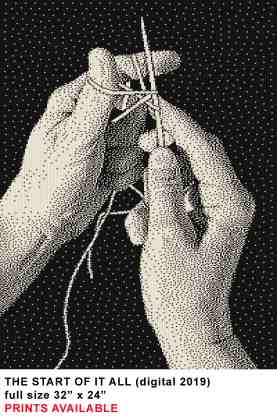
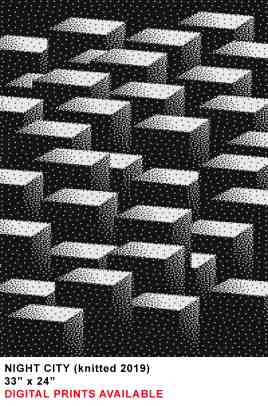
Both these works first existed as knitted pieces, and START has been exhibited all over the country as a knitted artwork. So having them accepted as digital works bolsters my confidence in my recent expansion of my work into the digital field.
I’m hoping to attend the opening of this exhibition on April 4 and look forward to being back in the D.C. area (more or less) where I had several great visits in 2019.
Also, the Delaplaine Arts Center will have 16 x 20-inch prints for sale of all the exhibited works, so this might be the first place prints of my work will actually be physically available. I’m VERY CLOSE to re-opening my Etsy shop, which will now be filled with affordable digital prints in several sizes (and custom portraits will be available again, too, in digital/printed format but still based on knitting), so keep an eye out here and on FB and IG for word on that.
January 31, 2020: Last year’s projects, this year’s projects
Although you can’t see it here, I have in fact done some thinking since February 2019. And I haven’t just sat around thinking; I’ve done quite a few other things as well. 😉 It was a very busy year.
During the spring of 2019 I finished four artworks that had been in process since the previous fall, and then used images of these pieces to make the video Shaping Reality in coordination with composer Jeff Rathbun, who wrote “Shapes,” a chamber music piece that became the video’s soundtrack. This was a new adventure for me and I loved it. I learned to use about a million new tools and had my mind thoroughly exploded as I saw what was possible with the simplest of starting materials. I used only photographs of the knitted pieces and digital images of their patterns, along with a few sequences of a wandering strand of yarn (created on an iPad with the app Procreate).
But here’s the weirdest thing that happened during this project: although the video and music were created very independently (all I had heard was the first minute of the music, and I knew it was going to be around ten minutes long when complete), when I first put the whole video and the whole midi recording together, they fit almost perfectly. And I don’t mean just that they were around the same total length—they were also broken up into the same number of thematic sections, and they seemed to breathe, and to rise and fall in intensity, at the same times. It was astonishing. It has given me more faith in my own sense of narrative and timing (not that they’re “correct,” but just that at least one other person whose artistry I very much respect seems to share them with me!).
I spent the summer preparing to teach my first workshop in the Washington, DC area. It went well and I felt like the students in my class were true kindred spirits. (I thought we even sort of looked like kindred, as you’ll see in the photo below.) We had a great time exploring applications of my ideas to both knitting and weaving—and my head exploded again as I learned about the way weavers look at images. (Weaving is the hobby I am afraid even to think about trying. The technical nature of weaving appeals to me immensely but I’m afraid to get started on something that will require more space, more books, more time…) Between the extensive class preparation and the things that I learned from the group, I’m beginning to think I need to write a book. But as you will see below, the subject of the book keeps growing and twisting…
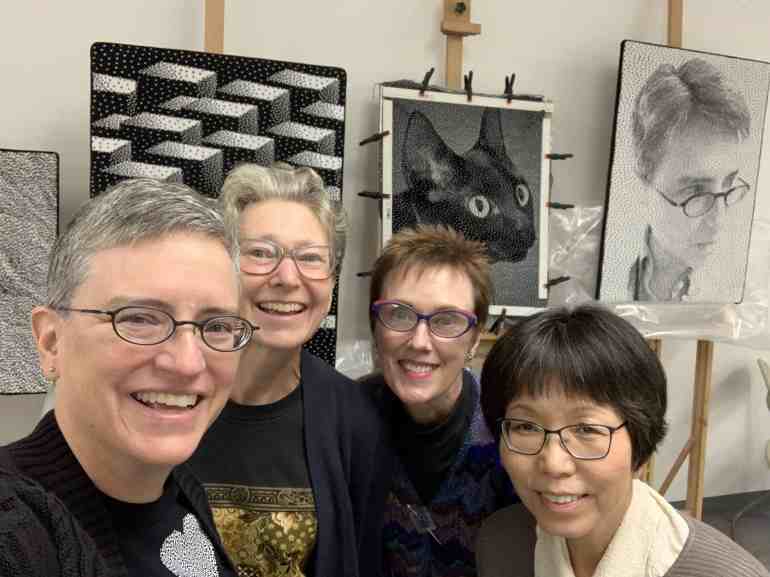
By late fall I wanted to try some other new, more open-ended projects. Of course, it was also time to move into holiday preparation mode, and that means preparing an image for my family’s holiday card. Conveniently these things worked well together, because here’s the newest, shiniest project I’m working on…

So…first some background. If you’re reading this, you know that I make knitted image from digitally manipulated patterns. What you might not know is that as I’ve learned to create the designs for these knitted pieces, I’ve also developed techniques for simulating the final appearance of the knitting, to help me judge when my patterns were ready to knit. And little by little, the simulations have become more accurate, to the point that from a distance (that is, when they are seen at the same apparent size) they are visually almost indistinguishable from the knitted works themselves.
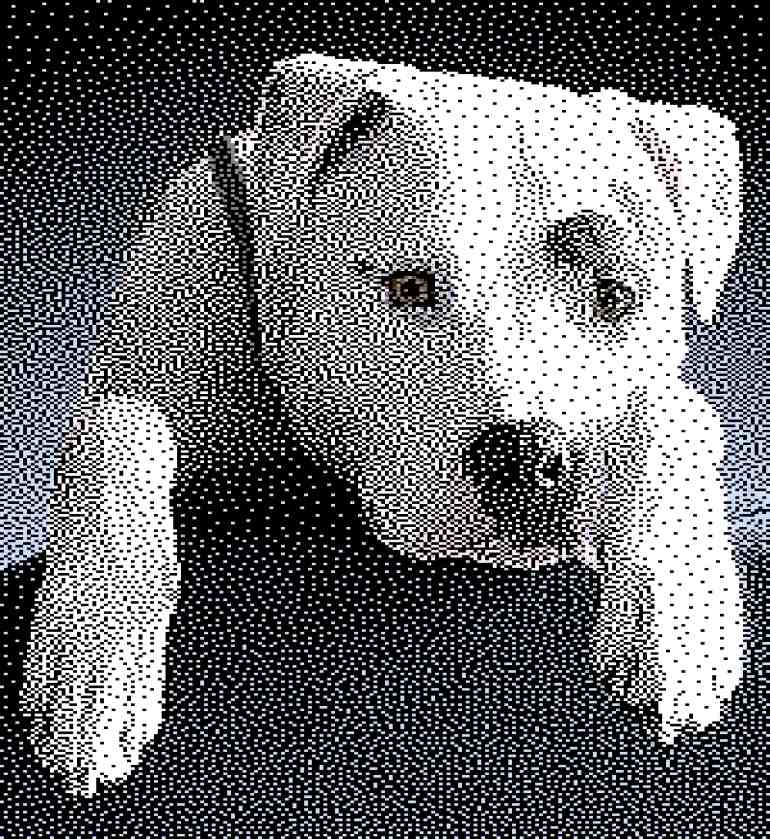
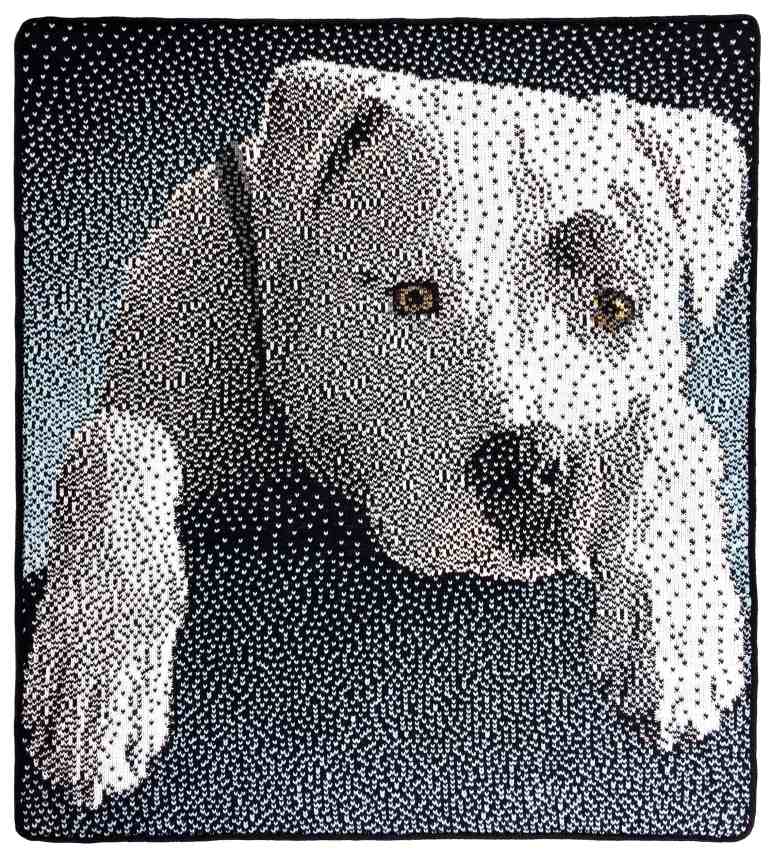
Recognizing what the simulations had become was a “lightbulb” moment, and I began to think that with a bit more work (actually it took quite a bit more work) I could make them even better. In fact, where I have previously always created knitting that looks like prints, I thought I might now be able to create prints that look like knitting (that is, digitally printed images of simulated knitting). And I can imagine some people wondering why this had any particular appeal…but to me it sounded like magic, and represented an entirely new way to add a layer of both illusion and visual texture, and a wildly interesting method for creating works that are simultaneously extremely LOW-resolution (because the “actual” image is made up of stitches, which are very large in relation to pixels) and extremely HIGH-resolution (because the image of each individual stitch is extremely detailed and contains many, many pixels).
So that’s the NEW “twist” I’m working on now. The initial work on these designs is done the same way it always has been, following all the principles required for making physical knitted pieces. The colors I use are even restricted (voluntarily) to those I can actually find in yarn. These designs could, and eventually may, be physically knitted. But once the initial design is created, the new, added process requires that I break it down into its smallest essential parts, then rebuild and transform it into a replica of my own actual knitting. This is key; it’s not just “generic” knitting, it’s not just a semi-transparent overlay that looks something like knitting, but rather it is a stitch-by-stitch simulation of my own knitting. The resulting works are like fully realized thought experiments, the essence of what a knitted image can be—the ultimate expression of what my knitting can be.
And here’s how this fits with my 2019 holiday cards—see, it IS related! This year’s card was a perfect opportunity to try my new methods on a project where printing, rather than knitting, was already the ultimate goal. So I made some extremely rough sketches (with my finger on the Procreate app on my phone)…
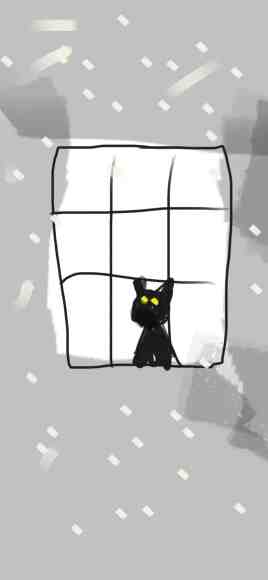
And took some photos of our new cat, Zelda (this was not difficult; we take a LOT of photos of her)…

I used all my existing editing methods + all my new editing methods to produce the extremely high-resolution final image of SIMULATED knitting. The printed cards are too small to show much detail for each stitch, but the detail is very much there…

And here is the final design for our cards…
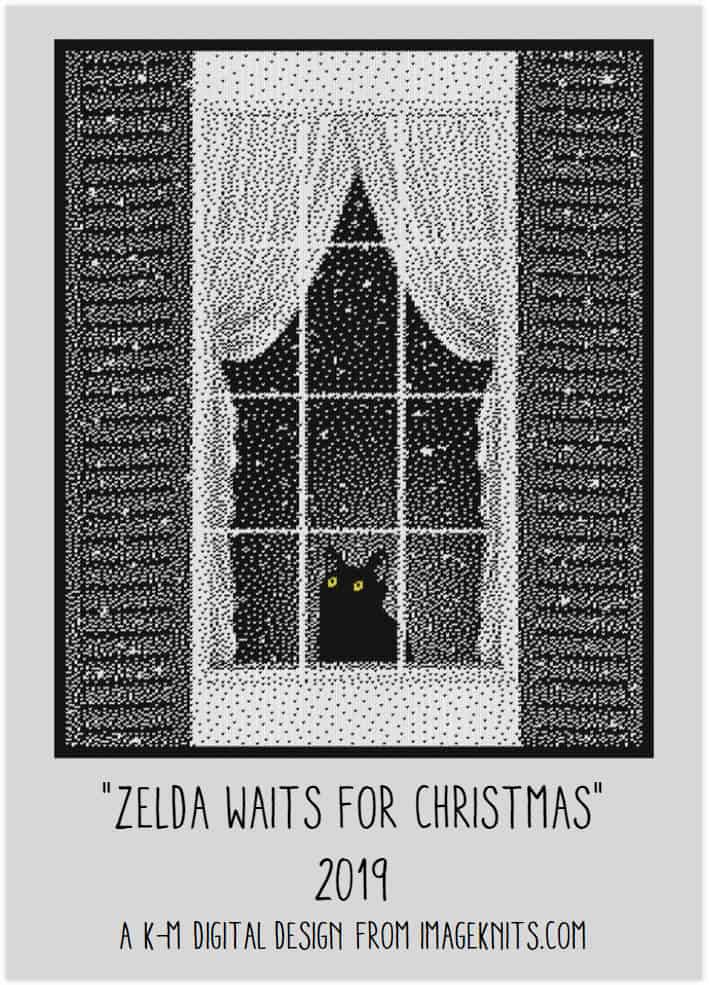
So this is what I’m working on now. I’m converting many of my previously knitted designs using these methods, so that they become entirely DIGITAL designs. You’ll see them appear on the main (portfolio) page of my website as they are converted—each converted artwork will now have a little carousel of images showing both the knitted and digital designs, details of both, and some text or other material as appropriate. Completely new digital designs will also be added soon—there are several in the works right now.
I find these entirely digital artworks really exciting to work on, and hope the new processes will allow me to create many new pieces in 2020. Don’t worry; this isn’t replacing knitting, but is rather an extension of my previous work. And the digital designs offer another huge advantage—they can easily be printed, in various sizes and on various media, so they’re going to be available soon at a wide and friendly range of price points. I will also have much more availability for custom commissions on these designs, because each piece will not require a month or more of hand work to complete (as the knitted custom pieces usually do)!
So stay in touch and let me know what you think of this digital expansion of my work! I do plan to write here more often this year, with another post soon to talk more about some concepts behind this expansion into purely digital designs, why they interest me, and how I hope to expand them further (this is how the book that is writing itself in my head keeps mutating). I also hope these new methods will allow me to bring you more designs than ever, with the goal of having a fully built-out catalog of works.
As always, I’ll keep trying to show you my view the world—sometimes sharply critical, occasionally reverent, often deliberately ambiguous—through a knitted lens. I invite you to look through this lens with me and explore the surprises I create.
February 10, 2019: Guest blog post at Fiber Art Network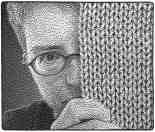
Read One Stitch = One Pixel: The Art Knits of Melinda Stees here.
January 22, 2019: What is kilo-minimalism?
Making my knitted images starts with the principle that one stitch equals one pixel. But knit stitches are generally MUCH larger than printed pixels—in fact they are about 1000 times larger—and I have begun using the term kilo-minimalism to describe how the images work in spite of this size difference. My works are minimalist in that they use a very small number of pixels (stitches), but they are kilo in scale because of that 1000x size difference between pixels and stitches. To “blow up” an image the way I do would in some contexts be considered unhelpful because the process adds what microscopists call empty magnification—the image gets larger, but there is no new information added. In my pieces, though, the enlargement process paradoxically adds visual impact and interest. The strong contrasting colors can catch your eye from across a room, while the knitted texture will pique your curiosity when you’re up close enough to see it.
My work st = px playfully turns the “one stitch = one pixel” rule on its head (see more about this below), because in it every “stitch” gets one pixel…except where it does not (in the images of huge knit stitches). A “twisted” sense of humor may help you get the joke.
To see what I’m talking about, look at this:
st = px
January 20, 2019: Artwork as drama
Some of my pieces have begun to feel like theatrical works as much as artworks, as if they are tiny dramas presented as a single, static scene on a simple stage set. The stories are acted out either by mannequins—posed in great detail that requires me to think as an actor, as if I were in the mannequin’s place—or by nothing more than hands, which I have always seen as full of personality and revealing of character. I am the least actor-ly person I know, and I am inept at deliberate emotional subterfuge and misdirection, but in my little (mostly digital) mannequins I have found a safe space to try out “speaking” messages I’d have a hard time delivering in person. And in telling stories with hands, I’m “acting” on a long-held fascination with how expressive (if sometimes inadvertently) our hands can be. Whichever set of performers I’m using, making these little dramas is an absorbing process, and there are endless stories still to knit!
To see what I’m talking about, look at these:
THE START OF IT ALL
GRANDAD
GRANDAUGHTER
YOU KNOW YOU WANT TO
IN THE MIRROR (ALL I SEE IS ME)
HOW MUCH HIGHER?
How will YOU take a stand? (Unexpected 3D #1)
March 2018: The rule of stitch = pixel
Working with yarn = THINKING: about gauge, graphs, and how to make a 3D thing out of a single strand. And making art = SEEING: with a pencil, camera, or Photoshop. I search for ways to engage both THINKING and SEEING, and to compel the viewer not just to look, but to puzzle over some surprising mix of subject, method, material and scale—small things made large; large images blurred with ultra-low resolution; pictures painted in yarn; yarn morphed into pixels. I want you to wonder and ask questions about what you see. You may ask some of the same questions I asked when I made the work; it’s even better if you ask different ones.
My pieces are knitted poster-size artworks. They are big enough to startle, and to insist that every portrait subject, whether human or animal, is a hero, and every inanimate object has its own secret beauty. Up close, each piece looks something like the surface of a sweater, but back away and you will see a picture of near-photographic detail that catches your eye from across the room.
The fundamental principle behind my manipulation of images, and their presentation in knitted yarn, is that one stitch = one pixel. A knitted stitch (st) is much larger than a printed pixel (px), so a knitted image will contain far fewer stitches than the pixels in a printed image of the same size. My knitted images are essentially digital images, though, and in the presentation of digital images, pixels are the carriers of information; therefore I want as many pixels (stitches) as I can get in order to communicate as much visual information as possible. My work involves constant experimenting with ways to negotiate this conflict, and to make every pixel count.
Of course, the fundamental principle that one stitch = one pixel can be playfully turned on its head, too, as in my piece st = px, in which every stitch gets one pixel…except where it does not, in the very large stitches pictured on one side of the piece. I also happily admit taking advantage of the fact that most people never have seen any sort of knitted artwork before, and I love to twist this unfamiliarity, sometimes with humor and a little sleight-of-hand, to make my knitting simulate some other medium or material, from photography to sketching or painting, from old-fashioned analog printing to hand-torn paper.
I have several special interests that often lead me to the subjects of my works:
- Most recently, I have begun exploring ideas about people through a buffer of posed mannequins. I find it’s a way to express challenging thoughts with softer edges, so that they slither rather than bludgeon their way into the mind of the viewer. An added benefit is that it gives me a potentially limitless army of cooperative models with which to enact any scenario I can imagine!
- I also enjoy trying to capture both human and animal personalities in portraits, a very different process from expressing ideas using anonymous mannequins.
- The ongoing “Handwork Project” (begun with THE START OF IT ALL) will create a series depicting human hands working at all manner of skilled physical tasks, allowing me to explore the idiosyncratic, rugged beauty of these hardest-working, most essentially human parts of us.
- Finally, I love the challenge of showcasing microscopic organisms at mega-scale—how many pixels/stitches do you need to accurately and beautifully depict an object that is less than 1/10 of a millimeter in length?
All these subjects present their own difficulties in my low-res medium; they make me constantly question my assumptions about both what is possible, and what works best.
I use cotton yarn in 100+ colors, a vintage knitting machine, a unique internal mounting system and many types of handwork at every stage to create these pieces. My goal is to make work that is unlike anything you’ve ever seen before.

